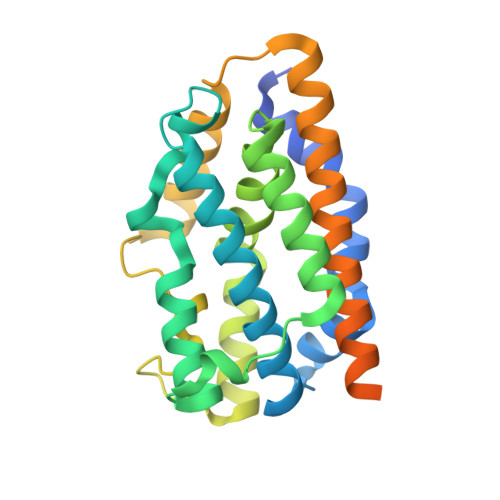Crystal Structures of Ferrous and CO-, CN(-)-, and NO-Bound Forms of Rat Heme Oxygenase-1 (HO-1) in Complex with Heme: Structural Implications for Discrimination between CO and O(2) in HO-1.
Sugishima, M., Sakamoto, H., Noguchi, M., Fukuyama, K.(2003) Biochemistry 42: 9898-9905
- PubMed: 12924938
- DOI: https://doi.org/10.1021/bi027268i
- Primary Citation of Related Structures:
1IX3, 1IX4, 1J02, 1UBB - PubMed Abstract:
Heme oxygenase (HO) catalyzes heme degradation by utilizing O(2) and reducing equivalents to produce biliverdin IX alpha, iron, and CO. To avoid product inhibition, the heme[bond]HO complex (heme[bond]HO) is structured to markedly increase its affinity for O(2) while suppressing its affinity for CO. We determined the crystal structures of rat ferrous heme[bond]HO and heme[bond]HO bound to CO, CN(-), and NO at 2.3, 1.8, 2.0, and 1.7 A resolution, respectively. The heme pocket of ferrous heme-HO has the same conformation as that of the previously determined ferric form, but no ligand is visible on the distal side of the ferrous heme. Fe[bond]CO and Fe[bond]CN(-) are tilted, whereas the Fe[bond]NO is bent. The structure of heme[bond]HO bound to NO is identical to that bound to N(3)(-), which is also bent as in the case of O(2). Notably, in the CO- and CN(-)-bound forms, the heme and its ligands shift toward the alpha-meso carbon, and the distal F-helix shifts in the opposite direction. These shifts allow CO or CN(-) to bind in a tilted fashion without a collision between the distal ligand and Gly139 O and cause disruption of one salt bridge between the heme and basic residue. The structural identity of the ferrous and ferric states of heme[bond]HO indicates that these shifts are not produced on reduction of heme iron. Neither such conformational changes nor a heme shift occurs on NO or N(3)(-) binding. Heme[bond]HO therefore recognizes CO and O(2) by their binding geometries. The marked reduction in the ratio of affinities of CO to O(2) for heme[bond]HO achieved by an increase in O(2) affinity [Migita, C. T., Matera, K. M., Ikeda-Saito, M., Olson, J. S., Fujii, H., Yoshimura, T., Zhou, H., and Yoshida, T. (1998) J. Biol. Chem. 273, 945-949] is explained by hydrogen bonding and polar interactions that are favorable for O(2) binding, as well as by characteristic structural changes in the CO-bound form.
Organizational Affiliation:
Department of Biology, Graduate School of Science, Osaka University, Toyonaka, Osaka 560-0043, Japan.
















